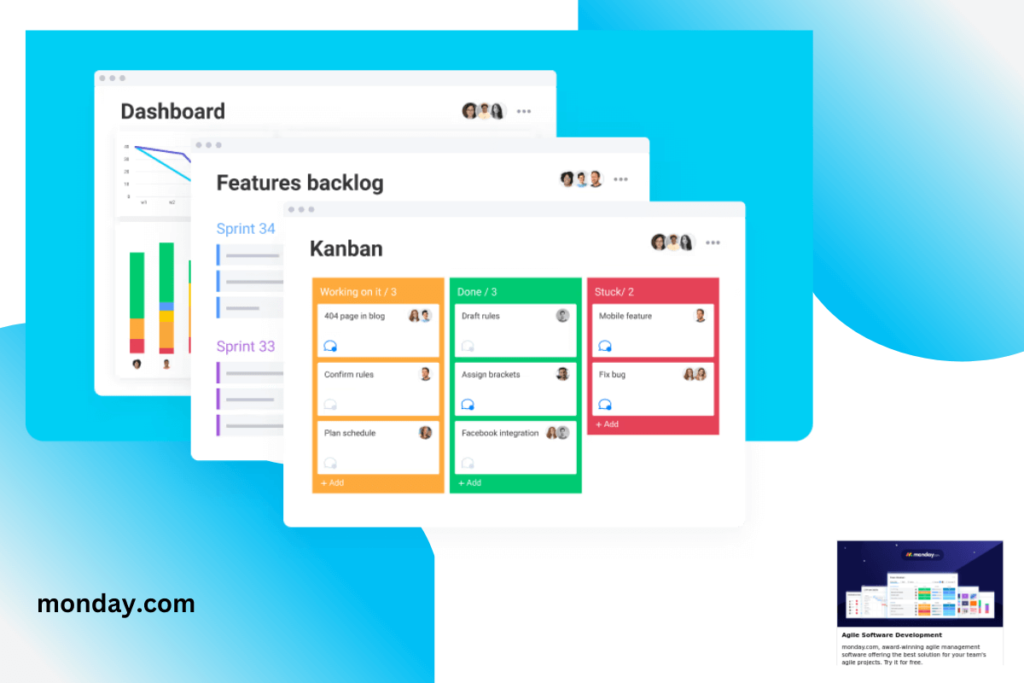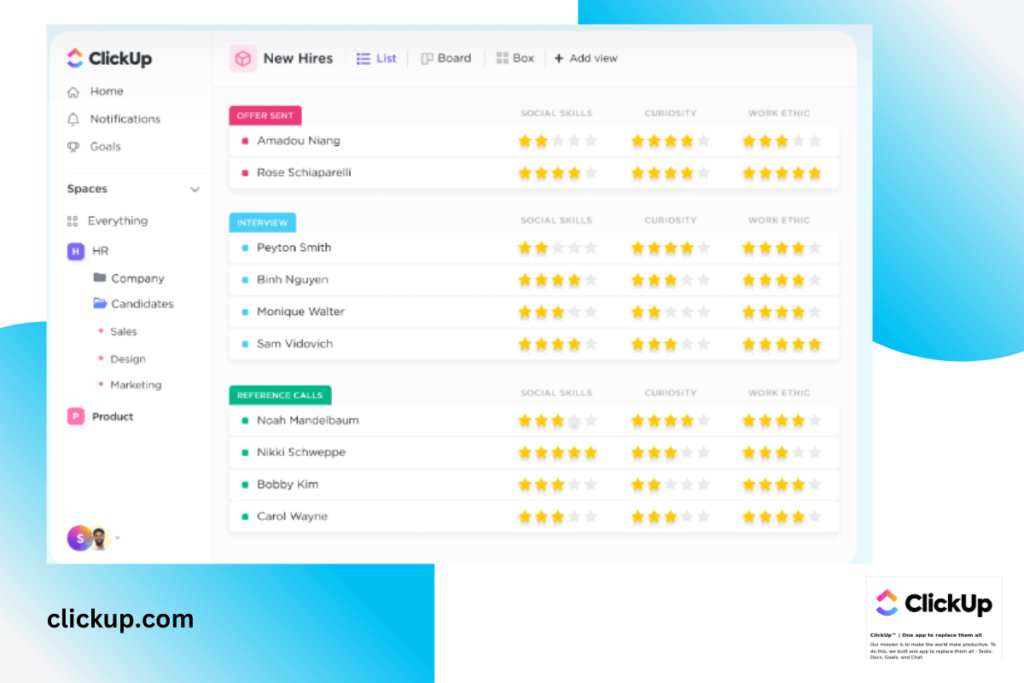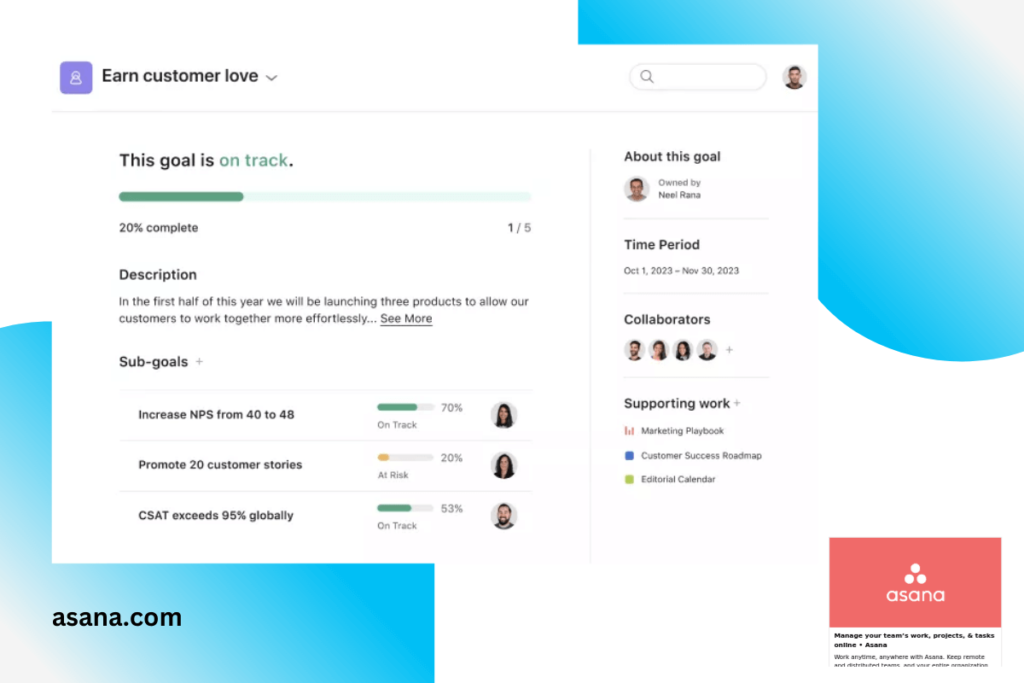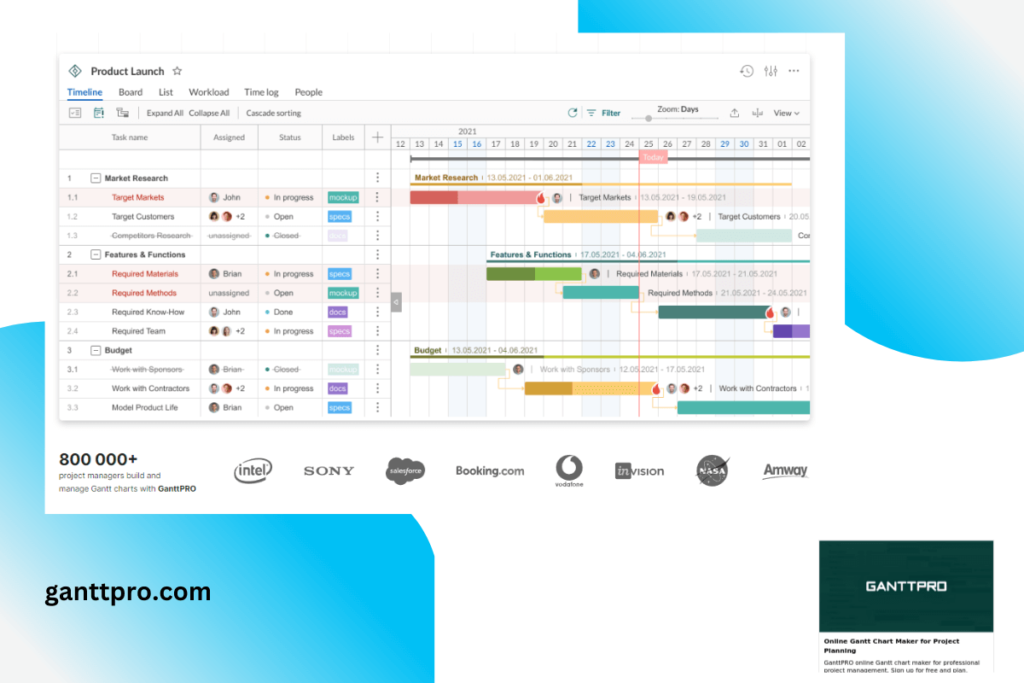Upfront Conclusion
The best project management software for game development right now is Monday.com and ClickUp
Gaming has been an increasingly popular hobby in recent years, and a growing popular acceptance of video games.
The coronavirus pandemic has also driven an increase in gaming as people have been more confined to their homes.
The video-gaming industry is an economic giant. In 2020, the gaming market in the United States was valued at more than 106 billion dollars.
Project management software for game development is designed to handle complex game development needs.
This article contains the top six project management software for game development.
- Small Business Performance Management Software
- Best Project Management Software For Video Production
- Project Management Software With Outlook Integration
- Cloud-Based Project Management Software
- Personal Project Management Software
- Project Management Software for Education
- Project Management Software For Dependency Tracking
- Project And Resource Management Software
- Free Time Management Software
- Small Business Resource Management Software
- HR Project Management Software
- Project Management Software For Musicians
- Collaborative Project Management Software
- Best Project Management Software With Email Integration
- Project Management Software with Recurring Tasks
- Monday.com vs Freshdesk
- Monday.com vs. Meistertask
- Monday.com vs. Smartsheet
- Monday.com vs. CoConstruct
- ClickUp vs Bitrix24
- ClickUp vs Confluence
- ClickUp Vs. Todoist
- Monday.com Vs. Float
- Monday.com vs Asana
- Monday.com vs Airtable
- ClickUp vs Asana
- ClickUp vs. Dubsado
- ClickUp vs Smartsheet
- Clickup vs Notion
- ClickUp vs Confluence
- What Does Workflow Management Software Do?
- What is the purpose of Project Management Software?
- What is “Portfolio” in Project Management Software?
- Is it Difficult to Use a Project Management Software Well?
- What Is FreshWorks & What Does It Do?
- Can Asana Be Used For Personal Use?
- What Are Some Unique Features of Project Management Software?
- Who Invented Project Management Software?
- What to Look for in Project Management Software?
- What Is The Most Popular Project Management Software?
- How To Use Project Management Software?
- How Much Does Project Management Tools Cost?
- How Much Does Project Management Software Increase Productivity?
- How To Create A Workflow Online
- What Are The Types Of Collaboration Software?
Why use Project Management Software for Game Development?
Without project management tools, game development is left without an organizational foothold.
The more people are involved in a project, the more difficult it is to manage without a centralized platform that maintains its vision and streamlines production pipelines.
Without a centralized location to keep everything ordered, your game project can easily deviate from its intended path.
Project management software is specifically designed to handle the needs of a complex development plan.
Many project management applications include useful features specifically designed to work with modern approaches to production work, such as Gantt charts and Kanban boards.
Other features to look for include time-tracking, invoicing, budgeting, and communication tools.
Tip: monday.com support multiple project views, including Gantt charts, timelines, calendars, and kanban boards.
What makes good Project Management Software for Game Development?
Good project management software for game development should have the following features:
- Task Management: The software should allow you to create and assign tasks to team members and set deadlines. It should also provide an easy way to track progress on tasks.
- Collaboration: Game development is a team effort, and the software should allow for easy collaboration between team members. This includes the ability to comment on tasks and share files.
- Bug Tracking: Game development can be complex, and bugs can arise. Good project management software should allow you to track and prioritize bugs, assign them to team members, and track their resolution.
- Agile Methodologies: Game development often uses agile methodologies, such as Scrum or Kanban. The software should support these methodologies and allow you to organize and prioritize tasks accordingly.
- Integration: The software should integrate with other tools used in game development, such as source control systems, art asset management systems, and game engines.
By having these features, good project management software can help game development teams stay organized, focused, and on track.
Tip: ClickUp allows you to track the time you spend on tasks, which can be useful for billing clients or analyzing your productivity.
How to choose the right Project Management Software for Game Development
Each game developer or project manager has distinct requirements.
Even though the majority of the project management software we’ll cover can accommodate most requirements, you still need to consider the priorities of your team.
Every game developer, from independent app developers to major gaming powerhouses, needs some sort of tool to manage the complex and detailed process of bringing a game from mind to market.
The size of your team and the difficulty of the job are crucial factors.
You should consider which specific features will be required the most once you have an idea of how the complete process should function.
We must not underestimate the importance of distinguishing features.
There are some features that are worth compromising.
Check to see if a software’s feature set fits with the long-term goals of your game development project(s).
Think about the size of your team, the complexity of your project, and what you truly need to get out of your project management tool.
These factors should drive your decision.
Tip: Asana supports team conversations within the context of specific tasks and projects.
Best Project Management Software for Game Development
| Brand | Starting price | Best for |
|---|---|---|
| 1. Monday.com | $8 – $16/month | Visual work management |
| 2. ClickUp | $5 – $19/month | All-in-one project management |
| 3. Asana | $10.99 – $30.49/month | Lightweight project management |
| 4. Codecks | €5/month | Game development teams |
| 5. Jira | $7 – $14/month | Agile method |
| 6. GanttPro | $6.50 – $15/month | Displaying project plan |
1. Monday.com

Work OS from Monday.com is a visual work management platform.
It requires no training and is visual, intuitive, and easy to use.
You will have access to over 200 ready-made templates based on real-life teams in action and can create your ideal workflow in minutes.
Work OS makes you and your team more efficient by effectively organizing your day-to-day.
Every idea starts with a visual board or table, and everything updates in real time.
You can see status buttons for all projects and steps and notify your team members, link boards, and add files all in one place.
Work OS allows you to keep track of all your moving pieces and streamlines your process and project so you can save time.
Work OS provides you with real-time access to data as simple or complex as you want it.
The platform works with Kanban, Calendar, Timeline, Gantt, map, form, and workload, so you can transform your data how you want to see it.
Timeline and Gantt views provide you with real-time deadline tracking, and teams always view their work in Calendar view.
No matter your screen size or device type, your team can quickly communicate and collaborate to meet deadlines.
Pricing
Independent developers can take advantage of Work OS’ free individual plan.
The platform’s Basic plan costs a mere $8 per month per team member and provides 5 GB of file storage.
The most-popular standard plan costs $10 per month per user and provides added support for automation.
The Pro plan further increases the functionality of the software and costs $16 per user per month.
Monday.com also offers a custom-tailored Enterprise plan for large companies.
2. ClickUp

ClickUp advertises itself as the app to replace all others. It handles tasks, documents, team chats, goals, and more.
The all-in-one project management software lets you build visual workflows, so you can crush your goals faster.
ClickUp easily lets you collaborate with your team in real time and move ideas to action faster.
You can easily add comments to any task or document and even assign actions, chat in real-time, and share attachments.
With real-time notifications across all your devices, you will never miss a beat.
A built-in global timer works across your desktop, mobile device, or Chrome browser and helps you set expectations and time estimates, and allows you to monitor time spent on specific tasks with detailed reports.
ClickUp’s dashboards allow you to see everything at a glance and can be tailored to meet your needs with visual widgets.
The platform supports List, Box, Gantt, Board, and Calendar views so you can always visualize your data how you want to arrange it.
Aligning your team has never been easier.
Mind maps, checklists, custom statuses, and goal tracking are all at your fingertips with ClickUp.
Pricing
ClickUp offers a free plan for independent developers that provides 100MB of storage.
Small teams will benefit from its Unlimited package which costs $5 per user per month.
Its Business plan is best for medium-sized teams and adds additional features for $12 per month per user.
Business Plus further adds to the features list and costs $19 per user per month.
ClickUp also offers a customizable Enterprise package for large teams.
3. Asana

Popular with game development teams, Asana is a lightweight project management tool that is designed to function within the Agile method.
Project managers can create sprints, add members and tasks, and track task assignments and statuses on a built-in dashboard.
For unique needs, sprints can be customized with new or additional fields.
Tasks within sprints can be automated.
If a team member marks a task as completed, Asana can automatically move that task to a different column on the dash, update pending milestones, update other custom fields, and so on.
These automation features require a little bit of planning but add value in terms of simplicity when the sprint is live.
Asana’s Workload feature will help gauge the availability of your team based on their task assignments.
Oversaturated items or resources will be color-coded to bring attention.
For bug tracking, Asana offers comprehensive tools that allow the dev team to capture key bug details in a form.
These forms can be customized to the needs of your project.
Bug reporting forms can be shared with customers or employees who are not using Asana by means of a link.
Asana’s integration capabilities can be leveraged to turn these bug-reporting forms into actionable tasks that can then be managed from within Asana.
Pricing
Asana’s basic software begins with a “Free Forever” platform.
This includes unlimited tasks, projects, messages, and file storage of up to 100MB per file.
Users of this platform can work with up to 15 peers and have access to the iOS and Android mobile apps, as well as the option to integrate more than 100 popular tools into Asana.
For teams needing more, Asana offers a Premium package that bills at $10.99 per user per month billed annually, or $13.49 per user billed monthly.
This package features dashboards, advanced reporting tools, unlimited guest access, forms, an admin console, and custom fields.
For large development teams or bigger organizations, Asana offers a Business package.
While expensive ($24.99/user/month annually or $30.49/user/month billed monthly), this package offers access to custom rule building, form customization and branching, workload tools, and advanced integrations with tools like Salesforce and Tableau.
4. Codecks

Codecks is a project-management tool engineered specifically to meet the needs of game development teams.
Developed by the independent gaming firm Maschinen-Mensch, Codecks is designed to meet the different needs of visual artists, programmers, and project managers in one comprehensive tool.
Taking design cues from collectible card games, Codecks uses a card-based system to keep track of your project.
Cards are thoughtfully designed to convey as much information as possible with one glance using a system of icons and values.
Card management is simple and intuitive, allowing users to focus on the information rather than the program.
Cards
Cards have two forms: a detail view and a mini-card. Mini-cards display a condensed version of the information stored in the detail view.
When arranged on a board, the mini-cards can rapidly illuminate users regarding project status.
Many useful functions are attached to cards.
They can be assigned to workers, linked to milestones, prioritized, blocked, and arranged into dependencies.
Like their namesakes that exist in meatspace, cards can be arranged into decks to help keep track of larger task groups.
For example, cards could be arranged into decks for “Combat mechanics,” “Physics engine,” or “Bugs” to help keep the project team organized.
Multiple projects can be managed concurrently in Codecks.
Projects can be managed at a granular level, allowing users to select who can or cannot access certain cards or decks – perfect for companies employing freelancers or contractors who do not need full access to the project.
Other Tools
Codecks include a detailed time-tracking system linked to the cards.
A 3d artist could select the card for “Render mountain range,” and if time tracking is enabled, a clock will automatically begin tracking the time spent on this card.
Users can also manually enter time spent if a running clock is not the best solution for them.
Time-tracking automatically interfaces with a detailed reporting system.
This allows project managers to generate detailed reports on hours worked, money spent, resources used, and more.
These can then be integrated into a billing or invoicing system.
Communications with your team also occur within cards.
Cards are flagged to indicate that team members need feedback or that progress is blocked until something happens.
The team can use comment threads within cards, and conversations can be flagged as resolved to let team members know that a thread is concluded or an issue is solved.
Pricing
Codecks begins with a free platform, supporting up to 5 projects and up to 3 users with 1 gig of file storage.
A pro version runs 5 Euro per user per month and supports unlimited users and projects, plus a 5-gig per-user file storage.
Enterprise versions are available and offer onboarding and self-hosting capabilities on top of the other features of Codecks.
All in all, Codecks is a capable project management tool that is specifically designed to meet the needs of game development teams.
5. Jira

Jira is a project management application explicitly designed for project teams using the Agile method.
Scrum boards are built to facilitate team cohesion and collaboration, allowing rapid and transparent communication and detailed sprint planning.
Scrum boards can be configured to generate velocity and burn-down reports to concentrate their efforts on the most salient needs of the project.
Further facilitating Agile workflow methodologies, Kanban boards are also available in Jira, providing visual data regarding cycle times, bottlenecking, backlog, and more.
Roadmaps allow users to visualize the product from a wider point of view.
Users can see the project from a ‘big picture’ perspective and can use cross-project dependency tracking to avoid bottlenecks before they happen.
Moreover, roadmaps are used to wargame likely scenarios, allowing project managers to plan for contingencies.
Real-time updates keep your roadmaps current as team members complete tasks.
Integration with more than 3,000 software applications makes Jira customizable.
Teams using G-suite, Slack, and other applications can integrate these tools into the project management software.
Jira also offers complex automation tools, which allow automatic task assignments, synchronization of parent and child tasks, and automatic issue linking.
Game Dev Tools in Jira
Jira offers some features that are highly useful to game development teams.
A quick-start feature can get projects started in about five minutes.
During prototyping and modeling, files can be attached to project pages to keep the team on track and allow everyone to see the most recent iterations, prototypes, or changes.
A bug-tracking system allows developers to mark, index, and track bugs as they are captured and assigned for correction.
For code problems, Jira easily interfaces with Atlassian’s Crucible, a cloud-based code management system that allows multiple users to review and tweak code online.
This enables easy collaboration, even for remote teams.
Pricing
Like many project management tools, Jira offers users a basic version for free.
The free version supports up to ten users and includes access to major features such as Scrum and Kanban boards, reporting, customizable workflows, integrations, 2 gigs of storage, and dependency management.
For larger teams, Jira’s standard platform comes at $7 per user per month and offers access to advanced role/permission systems, audit tracing, and 250 gigs of file storage.
Premium users can unlock release tracking, admin insight tools, IP Whitelisting, and more for $14 per user per month.
6. GanttPro

GanttPro was built to focus on the fundamentals of project management.
As the name suggests GanttPro focuses on displaying project plans as Gantt charts.
This tool also supports a grid-based task management view, a card-based board view, and a portfolio view that provides a multi-project overview.
Project Managers can create a project baseline, develop a critical path, and use tools to compare the baseline to the current project state to evaluate progress.
There is a Project Health tool that evaluates task progress and task completion.
Dependencies can be assigned, and the software will monitor for bottlenecks or other slowdowns in the development process.
Collaboration tools in GanttPro allow users to review and share attachments from their devices or G-Suite.
Notification tools allow you to stay on top of changing task statuses in real-time.
While there is a commenting and mentioning function in this tool, there is not a chat function per se.
Project managers can manage resources in depth using GanttPro.
Resources can be added to tasks such as labor, materials, or fixed costs, allowing detailed invoicing.
Changes are logged in real-time, and multiple assignees can be attached to tasks.
Team members can be assigned specific roles, and project managers can generate detailed calendars for their teams.
Resource management extends to time-tracking: teams can use task timers to monitor their time, and estimated durations can be assigned to tasks to generate budget projections.
Pricing
For small or independent developers, GanttPro offers users an individual version of the application starting at $15 per user per month.
Firms with up to 40 users can purchase access to GanttPro’s Team plan, which costs $6.50 per user per month; larger development companies may wish to purchase the Enterprise version.
Where do video games come from?
Game development is a long and complex process, beginning with pre-development.
This phase of game development includes defining what the game is about, who the audience is, what platform it will be released on, the available development budget, and so on.
Pre-development is essentially a planning and ideas stage.
After pre-development comes the production phase.
This is the stage where games are refined.
The development team creates storyboards, characters, models, assets, mechanics, worlds, levels, and more during the production phase.
Once production is complete, games are launched to market.
Launching a new game does not complete the process. Games enter the post-production phase after they are released.
This is where the development team maintains the game with patches and bug fixes.
There may also be secondary content such as downloadable content (DLC), expansions, or bonus levels.
For a project manager overseeing game development, this is an intense, complicated, and heavily involved process with many moving parts.
Utilizing project management software can help the development team keep track of their tasks and ensure that the game development process runs as smoothly as possible.
The Last Level
The market for video games is strong and growing stronger.
Access to less expensive consumer electronics, pandemic lockdowns, and a growing realization that video games are a great way to have fun for almost anybody is driving this growth.
Staying competitive in this world requires organization and drive.
The drive is already inside you – and we hope that learning more about these project management tools will help you find the organization and workflow that you need to succeed.
RELATED: Marketing Departments Project Management Platforms | Top Automotive Shop Project Management Software | Top Noob Project Management Software
